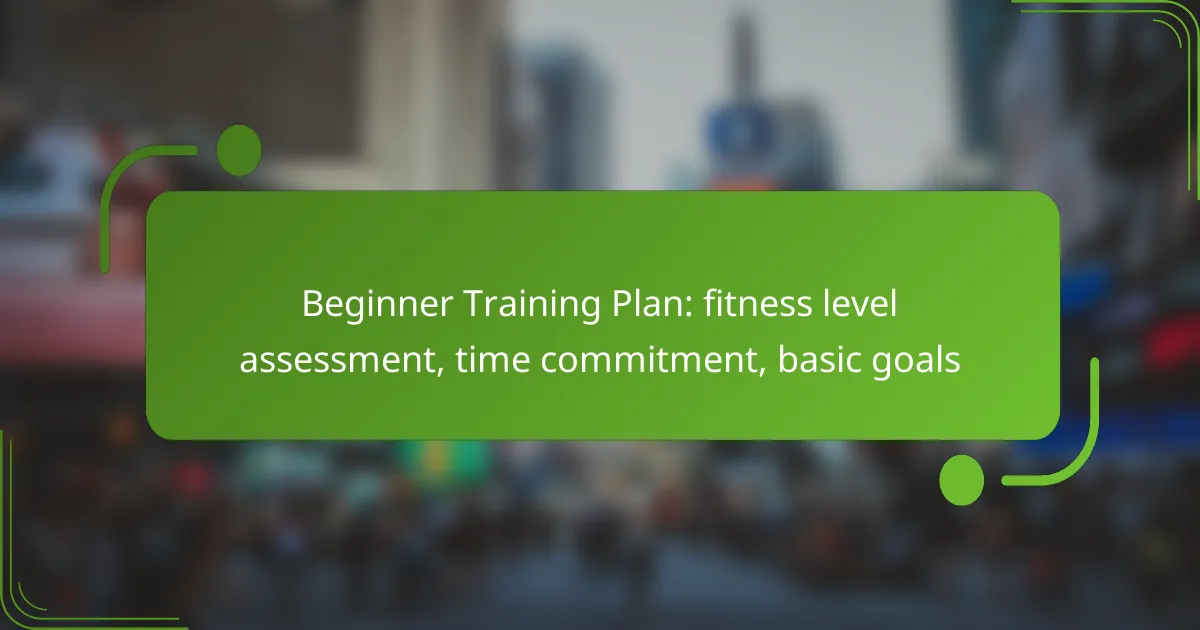Creating a beginner training plan starts with assessing your fitness level, which helps identify strengths and weaknesses while setting realistic goals. A typical commitment of 3 to 5 hours per week is recommended, balancing workouts with necessary recovery. Focus on achievable objectives like weight loss, muscle gain, or improved endurance to stay motivated and track your progress effectively.

How to assess your fitness level for a beginner training plan?
Assessing your fitness level is crucial for creating an effective beginner training plan. This evaluation helps identify your strengths and weaknesses, allowing you to set realistic goals and track your progress over time.
Body composition analysis
Body composition analysis measures the proportion of fat, muscle, and bone in your body. Common methods include skinfold measurements, bioelectrical impedance analysis, and DEXA scans. Aim for a body fat percentage that aligns with general health guidelines, typically around 20-30% for women and 10-20% for men.
To perform a simple self-assessment, you can use a tape measure to check your waist circumference. A waist measurement above 35 inches for women and 40 inches for men may indicate a higher risk of health issues.
Cardiovascular endurance tests
Cardiovascular endurance tests evaluate how well your heart and lungs supply oxygen during physical activity. A common test is the 1-mile walk or run, where you time yourself to see how quickly you can complete the distance. A good benchmark for beginners is completing it in under 15 minutes.
Another option is the 3-minute step test, where you step up and down on a platform for three minutes and then measure your heart rate immediately after. This can help gauge your cardiovascular fitness level.
Strength assessment
Strength assessment involves measuring how much weight you can lift for various exercises. Beginners can start with bodyweight exercises like push-ups, squats, and lunges. Track how many repetitions you can perform with good form to establish a baseline.
If you have access to weights, consider testing your maximum lift for exercises like the bench press or deadlift. A reasonable starting goal is to lift about 50-70% of your body weight for one repetition.
Flexibility evaluation
Flexibility evaluation assesses the range of motion in your joints and muscles. A simple test is the sit-and-reach test, where you sit on the floor and reach toward your toes. A good score is reaching within 2-4 inches of your toes.
Incorporating regular stretching routines can improve flexibility over time. Aim for at least 10-15 minutes of stretching after workouts, focusing on major muscle groups.
Functional movement screening
Functional movement screening identifies movement patterns that may indicate weaknesses or imbalances. This can include tests like the squat test, where you assess your ability to perform a squat with proper form. Look for any discomfort or difficulty during the movement.
Consider working with a fitness professional to conduct a comprehensive screening. They can provide insights and recommendations tailored to your specific needs, helping to prevent injuries as you progress in your training.

What is the time commitment for a beginner training plan?
A beginner training plan typically requires a commitment of several hours per week, balancing workouts with recovery. Most plans suggest around 3 to 5 hours weekly, depending on individual goals and fitness levels.
Weekly workout schedule
A standard weekly workout schedule for beginners often includes 3 to 4 sessions. Each session can vary in focus, such as strength training, cardio, or flexibility exercises, allowing for a well-rounded fitness approach.
For example, a common schedule might include two days of strength training, one day of cardio, and one day of active recovery like yoga or walking. This structure helps to build a foundation while preventing burnout.
Daily time allocation
Daily time allocation for workouts can range from 30 minutes to 1 hour. Beginners should aim for shorter, more manageable sessions that fit into their daily routines without overwhelming them.
For instance, a 30-minute session could involve a quick warm-up, followed by 20 minutes of focused exercise, and a short cool-down. This approach helps maintain motivation and consistency.
Long-term commitment expectations
Long-term commitment to a training plan is crucial for achieving fitness goals. Beginners should be prepared to adjust their schedules and gradually increase workout intensity and duration over time.
As fitness levels improve, individuals may find they need to dedicate more time, potentially reaching 5 to 7 hours per week for continued progress. Setting realistic milestones can help maintain focus and motivation throughout the journey.

What basic goals should beginners set?
Beginners should focus on achievable fitness goals that promote overall health and motivation. Common objectives include weight loss, muscle gain, and improving endurance, each requiring different strategies and time commitments.
Weight loss targets
For beginners aiming for weight loss, a realistic target is to lose about 0.5 to 1 kg (1 to 2 pounds) per week. This can typically be achieved by creating a calorie deficit through a combination of diet and exercise.
Incorporating regular physical activity, such as cardio workouts and strength training, can enhance weight loss efforts. It’s essential to track food intake and adjust portion sizes to meet caloric goals without feeling deprived.
Muscle gain objectives
Beginners looking to gain muscle should aim for a gradual increase in strength and muscle mass, typically around 0.5 to 1 kg (1 to 2 pounds) of muscle per month. This process involves consistent resistance training and adequate protein intake.
Focusing on compound exercises, such as squats and bench presses, can maximize muscle growth. It’s important to allow for recovery time between workouts to facilitate muscle repair and growth.
Improving endurance
To improve endurance, beginners should set goals to gradually increase their cardiovascular fitness over several weeks. A common target is to enhance stamina by being able to sustain moderate-intensity exercise for 20 to 30 minutes continuously.
Incorporating activities like running, cycling, or swimming into a weekly routine can help build endurance. Beginners should aim for at least 150 minutes of moderate aerobic activity per week, spread across several days.

What equipment do beginners need for training?
Beginners need basic equipment to start their fitness journey effectively. Essential items include versatile tools that support a variety of exercises, ensuring a well-rounded approach to training.
Essential home gym equipment
For a beginner’s home gym, consider investing in a set of dumbbells, resistance bands, and a yoga mat. Dumbbells allow for strength training across multiple muscle groups, while resistance bands provide versatility and can be adjusted for different fitness levels. A yoga mat offers comfort for floor exercises and stretching routines.
Additionally, a stability ball can enhance core workouts, and a jump rope is excellent for cardiovascular fitness. These items are generally affordable and can fit into small spaces, making them ideal for home use.
Recommended fitness apps
Several fitness apps cater to beginners, providing guided workouts and tracking progress. Apps like MyFitnessPal help monitor nutrition and caloric intake, while others like Nike Training Club offer structured workout plans tailored to various fitness levels.
Consider using apps that provide video demonstrations and customizable routines, such as Fitbod or JEFIT. Many of these apps are free or offer premium features at a reasonable monthly subscription, making them accessible for most users.
Popular workout gear brands
When selecting workout gear, brands like Nike, Adidas, and Under Armour are well-regarded for their quality and performance. These companies offer a range of apparel and footwear designed for comfort and durability during exercise.
For budget-friendly options, consider brands like Champion or Reebok, which provide reliable gear without breaking the bank. Always look for gear that offers good moisture-wicking properties and flexibility to enhance your workout experience.

How to create a balanced beginner training plan?
A balanced beginner training plan combines strength training, cardio workouts, and flexibility exercises to promote overall fitness. It should consider your current fitness level, time commitment, and specific goals to ensure sustainable progress.
Incorporating strength training
Strength training is essential for building muscle, increasing metabolism, and improving overall body strength. Beginners should aim for two to three sessions per week, focusing on major muscle groups such as legs, back, chest, and arms.
Start with basic exercises like squats, push-ups, and lunges, using body weight or light weights. Gradually increase the intensity by adding resistance or more complex movements as you gain confidence and strength.
Keep in mind to allow at least one rest day between strength training sessions to promote recovery and prevent injury. A balanced approach includes both upper and lower body workouts to ensure even development.
Including cardio workouts
Cardio workouts are crucial for improving cardiovascular health and burning calories. Beginners should aim for at least 150 minutes of moderate-intensity cardio each week, which can be broken down into manageable sessions of 20 to 30 minutes.
Activities such as brisk walking, cycling, or swimming are excellent choices. Incorporating intervals, where you alternate between higher and lower intensity, can enhance your fitness level more quickly.
To make cardio enjoyable, consider joining group classes or finding a workout buddy. This social aspect can help maintain motivation and consistency in your training plan.
